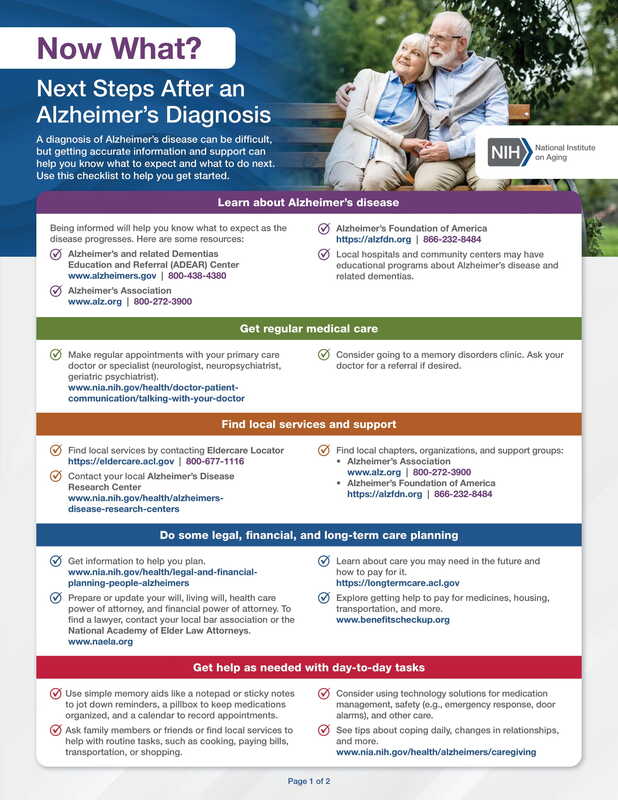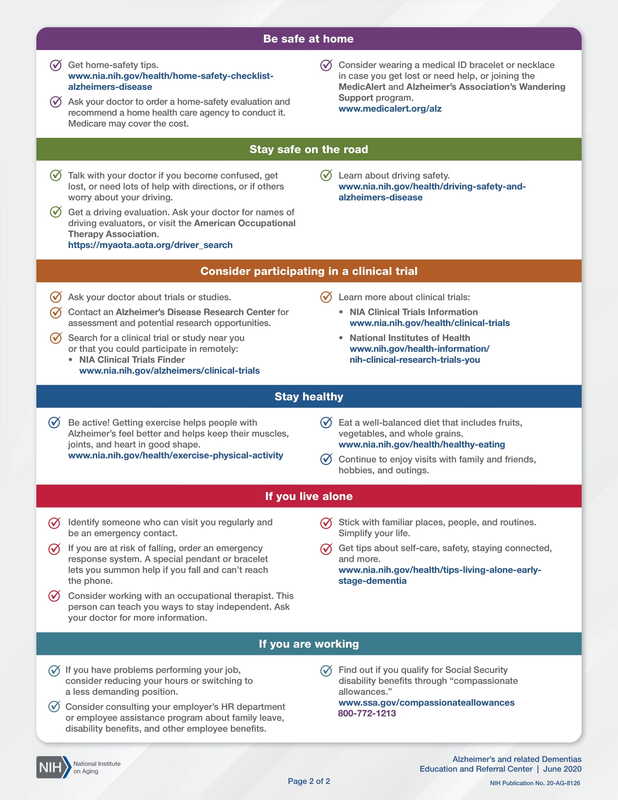|
If you're reading this, it's likely that you or someone you love has recently been diagnosed with Alzheimer's disease. While this news can be devastating, it's important to remember that you are not alone. There are millions of people across the globe who are currently living with Alzheimer's, and many more who are providing care for loved ones with the disease. In this blog post, we'll provide some tips for caregivers to help you navigate this new chapter in your life.
1. Accept the diagnosis. This may be one of the most difficult things to do after an Alzheimer's diagnosis, but it is crucial in order to move forward. Denial will only make the situation more difficult for both you and your loved one. If you need help accepting the diagnosis, consider seeking out a support group or speaking to a counsellor. Remember, you are not alone in this. 2. Learn as much as you can about the disease. The more you know about Alzheimer's, the better equipped you will be to deal with the challenges it presents. There are many excellent resources available online and through local organizations like the Alzheimer's Association. Take advantage of these resources so that you can be prepared for what lies ahead. 3. Prepare legal and financial plans. Legal planning may involve Powers of Attorney for both finances and health care. This ensures that someone else can make decisions for your loved one when they are no longer able to do so. Financial planning can help to ensure that assets are protected and that your family is taken care of financially. Long-term care planning involves making decisions about where the person will live as the disease progresses and how care will be provided for. A Will, will make sure assets and final affairs are handled in accordance with your loved ones wishes. These can be difficult conversations to have, but they are important ones. Putting a plan in place early on can help to make things a little easier down the road. 4. Conduct a home safety assessment. After an Alzheimer's diagnosis, it's important to take steps to ensure the safety of your loved one. This may include making changes to the home environment, such as removing hazards and installing safety features like handrails and grab bars. You may also need to provide close supervision and assistance with activities of daily living. In some cases, it may be necessary to move your loved one into a facility that can provide the level of care and support they require. Regardless of the approach you take, safety should be a top priority in your caregiving plan. By taking proactive measures, you can help your loved one live a safe and fulfilling life despite their diagnosis. 5. Put together a care team. Caring for someone with Alzheimer's can be overwhelming, so it's important to build a supportive network of family and friends who can help with both practical tasks and emotional support. You should also consider enlisting the help of professional caregivers, such as a home health aide or registered nurse. This can give you some much-needed respite from your caregiving duties and ensure that your loved one is receiving high-quality care when you can't be there yourself. 6. Make sure your loved one is getting proper medical treatment. Alzheimer's is a progressive disease, which means that it will continue to get worse over time. However, there are treatments available that can help slow down its progression and ease some of its symptoms. Work with your loved one's doctor to develop a treatment plan that meets their needs and includes both medical and non-medical interventions. Caring for someone with Alzheimer's disease can be challenging, but it is also rewarding. By taking the time to learn about the disease and put together a supportive care team, you can make sure that your loved one receives the best possible care during this difficult time. Downsizing can be a difficult process for seniors. They may have been living in their home for many years and have accumulated a lot of belongings. In addition, they may feel overwhelmed by the thought of downsizing and unsure of where to start. These 4 simple steps can help make the downsizing process a little easier.
1. Start by sorting through your belongings and deciding what you want to keep. Start by sorting through your belongings and deciding what you want to keep. This can be a difficult process, but it's important to be honest with yourself about what you really need. If you're not sure whether or not to keep something, ask yourself if you've used it in the past year. If the answer is no, then you probably don't need to keep it. Giving away cherished belongings to friends or family may make it easier to let go of some items knowing it will go to someone who will appreciate it. 2. Donate or sell items that you don't want or need anymore. Donating or selling unwanted items is a great way to downsize your belongings while also helping others. There are many charities that will accept donations of gently used clothing, furniture, and household items. You can also sell items online or at garage sales. If you find it is difficult to give up a particular item, consider taking a picture of it instead of keeping the item itself. Often it is the memory attached to an item that makes it important to us and a picture can help keep the memory alive instead of packing an item you may not actually need or use. 3. Pack up what's left and store it somewhere safe. Packing up your belongings can be time-consuming, but it's important to take the time to pack things appropriately. Wrap fragile items so you don’t break things you will need and label each box with its contents and the room it should be stored in. This will make it easier to find items when you need them and will prevent you from having to unpack and repack boxes unnecessarily. If possible, try to store boxes in a self-storage unit or in a friend or family member's home until you are ready to make the move. 4. Take your time when downsizing and don't rush through the process. Downsizing can be an and emotional process. Try to give yourself enough time to go through your belongings and make decisions about what to keep and what to let go of. If you're not sure what to do with an item set it aside and come back to it later, there is no need to dwell on it. If you're feeling overwhelmed, take a break or ask for help from friends or family members. Remember, downsizing is an opportunity to simplify your life and get rid of things that are no longer serving you. Follow these simple tips and soon enough, you'll be finished and will be able to enjoy your new home! Do you have any other tips for downsizing? Share them in the comments below! |
AuthorTyice Strahl Categories
All
Archives
May 2023
|
- Home
-
Settings
- Assisted Living
- Home Care
- Independent Living
- Memory Care
- Skilled Nursing
- Adult Family Homes
-
All Communities
>
- Aspen Quality Care
- Avamere South Hill
- Brighton Court
- Brookdale Nine Mile
- Brookdale Park Place
- Cheney Assisted Living
- Cherrywood Assisted Living
- Colonial Court
- Cornerstone Court
- Evergreen Fountains
- Palouse Country
- Fairview Assisted Living
- Fairwinds
- Fairwood
- Fieldstone Memory Care
- Good Samaritan
- Maplewood Gardens
- Moran Vista
- North Point Village
- Orchard Crest
- Pine Ridge Memory Care
- Emilie Court
- Ridgeview Place
- Riverview Retirement
- Rockwood Retirement Community
- Rose Pointe Assisted Living
- Royal Park
- South Hill Village
- Sullivan Park Assisted Living
- Sunshine Health Facilities
- Touchmark Assisted Living
- Willow Grove
- Wind River
- Alderwood Manor
- Franklin Hills
- Manor Care
- North Central Care Center
- Providence St Joseph
- Regency at Northpointe
- Royal Park Health and Rehabilitation
- Spokane Veterans Home
- The Gardens on University
- Spokane Assisted Living Directory
- Locations
- Services
- About
- Senior Living Blog
- Contact




 RSS Feed
RSS Feed
